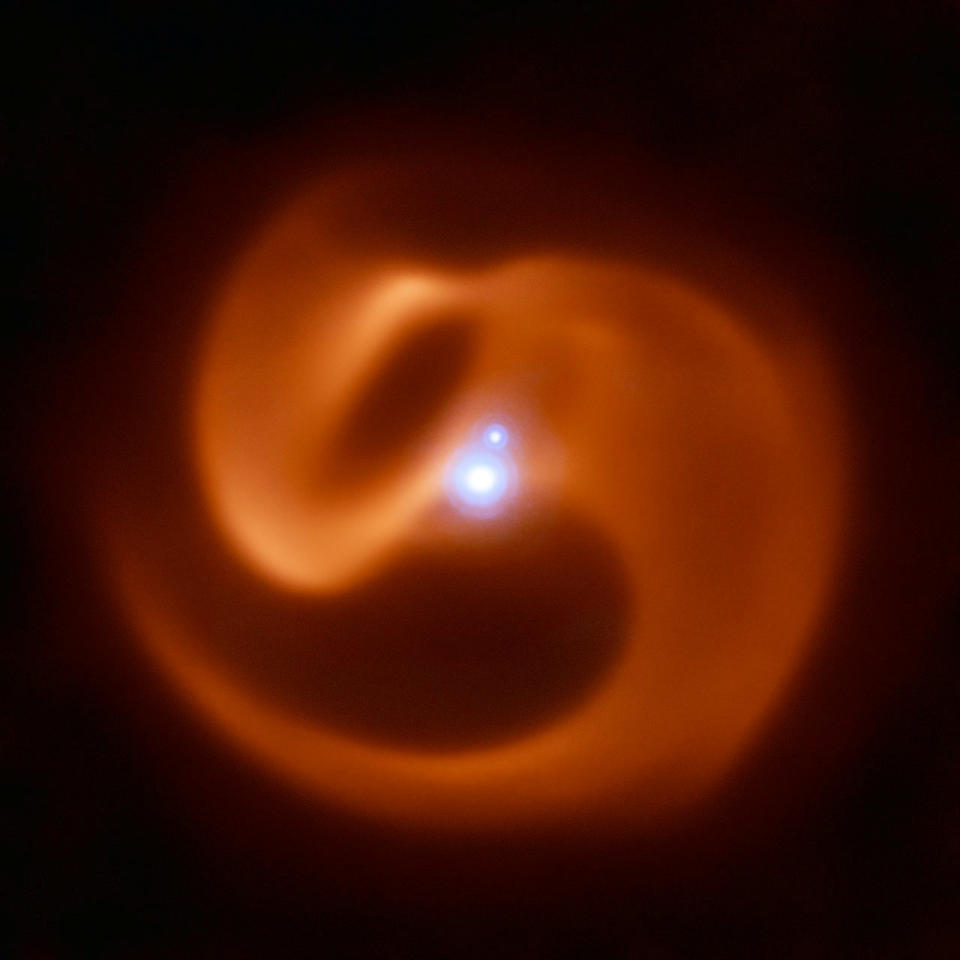Ultra-rare 'peacock' stars pictured in death spiral that could unleash gamma ray blast

Astronomers have captured the deadly beauty of a pair of huge, bright-burning stars locked in a death spiral that could culminate in a blast of deadly gamma rays.
The blast would scour the life from the surface of any nearby planets, although its axis of rotation means we are safe from any blast here on Earth.
Described as “peacocks of the stellar world”, the star system lies 8,000 light years away, with a beautiful spiral created by glowing carbon dust.
The star system is named after “Apep” – an Egyptian serpent god of chaos – and consists of two Wolf-Rayet stars revolving around each other while spewing out plumes of glowing carbon dust.
The research was published in Monthly Notices of the Royal Astronomical Society.
Read more: What are fast radio bursts, and why do they look like aliens?
Just one in 100 million stars are classified as Wolf-Rayet stars – ferociously bright, hot stars doomed to imminent collapse in a supernova explosion leaving only a black hole.
Professor Peter Tuthill of the University of Sydney, who first discovered Apep two years ago, said: "They are ticking time bombs.
"As well as exhibiting all the usual extreme behaviour of Wolf-Rayets, Apep's main star looks to be rapidly rotating.
"This means it could have all the ingredients to detonate a long gamma-ray burst when it goes supernova."
Gamma-ray bursts are among the most energetic events in the universe. And they are deadly.
Read more: Astronomers find closest black hole to Earth
Tuthill said: "If a gamma-ray burst were to impact Earth, it could strip the planet of its precious ozone layer, exposing us all to ultra-violet radiation from the Sun. Fortunately, Apep's axis of rotation means it presents no threat to Earth."
As the two stars orbit one another, the dust gets wrapped into a beautiful glowing sooty tail.
Researchers using cutting-edge high-resolution imaging techniques at the European Southern Observatory's Very Large Telescope at Paranal, Chile, were able to probe the underlying processes that create the spiral that we observe.
Taking pictures of the phenomenon was like trying to snap a chickpea sitting on a table 50 kilometres away, said the team.

Yinuo Han, a research student at the University of Sydney, said: “The two stars are each about 10 to 15 times more massive than the Sun and more than 100,000 times brighter.
“Where the surface of our home star is about 5,500 degrees, Wolf-Rayet stars are typically 25,000 degrees or more.”
According to the team's most recent findings, the massive stars in Apep orbit each other about every 125 years at a distance comparable to the size of our Solar System.
Read more: There might once have been life on the moon
Han said: "The speeds of the stellar winds produced are just mind-blowing.
"They are spinning off the stars about 12 million kilometres an hour; that's 1 percent the speed of light.
"Yet the dust being produced by this system is expanding much more slowly, at about a quarter of the stellar wind speed.
"It likely means that stellar winds are launched in different directions at different speeds. The dust expansion we are measuring is driven by slower winds launched near the star's equator.
"Our model now fits the observed data quite well, but we still haven't quite explained the physics of the stellar rotation."
Watch: Exploding star caught on camera

 Yahoo Movies
Yahoo Movies 
